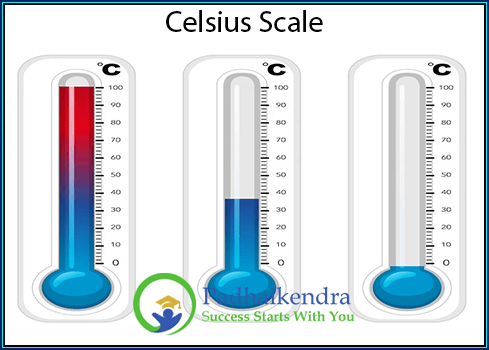The Celsius scale, also known as the centigrade scale, is a temperature scale commonly used in many parts of the world. It is named after the Swedish astronomer Anders Celsius, who first proposed the scale in 1742. The Celsius scale is based on dividing the temperature range between the freezing and boiling points of water into 100 equal intervals or degrees.
Here are some key points about the Celsius scale:
 Freezing and Boiling Points of Water: On the Celsius scale, the freezing point of water is defined as 0 degrees Celsius (°C), and the boiling point of water is defined as 100 degrees Celsius (°C), both at standard atmospheric pressure (1 atmosphere).
Freezing and Boiling Points of Water: On the Celsius scale, the freezing point of water is defined as 0 degrees Celsius (°C), and the boiling point of water is defined as 100 degrees Celsius (°C), both at standard atmospheric pressure (1 atmosphere).
Interval Size: The Celsius scale divides the temperature range between the freezing and boiling points of water into 100 equal intervals or degrees. Each degree of Celsius is equal to 1/100th of the temperature difference between the freezing and boiling points of water.
Absolute Zero: The Celsius scale does not have an absolute zero point, which is the lowest possible temperature. Instead, the Kelvin scale is used to measure absolute temperature, where 0 Kelvin (0 K) corresponds to absolute zero.
Common Usage: The Celsius scale is widely used in daily life, scientific research, and weather forecasting in many countries. It is the standard temperature scale used in most of Europe, Asia, and Oceania.
Conversion: The Celsius scale can be converted to the Fahrenheit scale (commonly used in the United States) using the formula:
°F = (°C × 9/5) + 32
Similarly, it can be converted to the Kelvin scale by adding 273.15:
K = °C + 273.15
The Celsius scale is a convenient temperature scale that allows for easy comparison and measurement of temperature. It is particularly useful in everyday contexts, as it aligns with the freezing and boiling points of water, which are significant reference points in many practical applications.
Celsius Scale FAQs
The Celsius scale is a temperature scale used to measure temperatures. It is defined based on the freezing and boiling points of water. On the Celsius scale, the freezing point of water is assigned the value of 0 degrees Celsius, while the boiling point of water is assigned the value of 100 degrees Celsius.
The Celsius scale is widely used globally and is one of the most common temperature scales. It is based on the metric system and provides a convenient and easily understandable way to measure temperatures, especially in daily life and scientific applications. However, it is worth noting that some countries, such as the United States, still use the Fahrenheit scale alongside the Celsius scale.
On the Celsius scale, the freezing point of water is 0 degrees Celsius, while the boiling point of water is 100 degrees Celsius at standard atmospheric pressure. These reference points on the Celsius scale provide a consistent and easily reproducible basis for temperature measurement.
The Celsius scale and the Kelvin scale are directly related. The Kelvin scale is an absolute temperature scale, where 0 Kelvin represents absolute zero, the lowest possible temperature. The Celsius scale is derived from the Kelvin scale by shifting the zero point by 273.15 units. Therefore, the relationship between the Celsius and Kelvin scales is given by the equation: Kelvin = Celsius + 273.15.
Yes, the Celsius scale can be converted to other temperature scales. One common conversion is to the Fahrenheit scale. The conversion formula is: Fahrenheit = (Celsius × 9/5) + 32. Additionally, as mentioned earlier, the Celsius scale can be converted to the Kelvin scale by adding 273.15 to the Celsius temperature.
The Celsius scale is widely used and accepted worldwide. It is the standard temperature scale in many countries and is commonly used in scientific research, daily life, and various industries. However, it is important to note that some countries, such as the United States, still use the Fahrenheit scale in addition to the Celsius scale.
Commonly encountered temperatures on the Celsius scale vary depending on the context. For example, room temperature is typically around 20-25 degrees Celsius, while the human body temperature is around 37 degrees Celsius. Freezing water is at 0 degrees Celsius, and boiling water is at 100 degrees Celsius.
The Celsius scale provides a reasonable level of precision for most everyday temperature measurements. It is commonly used in various fields and is suitable for general temperature monitoring and control. However, for specialized scientific research or industrial applications that require higher precision, more precise temperature scales may be utilized.
The Celsius scale is useful in everyday life for a wide range of applications. It allows us to measure and understand temperature changes, determine appropriate clothing for different weather conditions, monitor food storage and cooking temperatures, and regulate indoor heating and cooling systems, among many other practical uses.
 Freezing and Boiling Points of Water: On the Celsius scale, the freezing point of water is defined as 0 degrees Celsius (°C), and the boiling point of water is defined as 100 degrees Celsius (°C), both at standard atmospheric pressure (1 atmosphere).
Freezing and Boiling Points of Water: On the Celsius scale, the freezing point of water is defined as 0 degrees Celsius (°C), and the boiling point of water is defined as 100 degrees Celsius (°C), both at standard atmospheric pressure (1 atmosphere).




